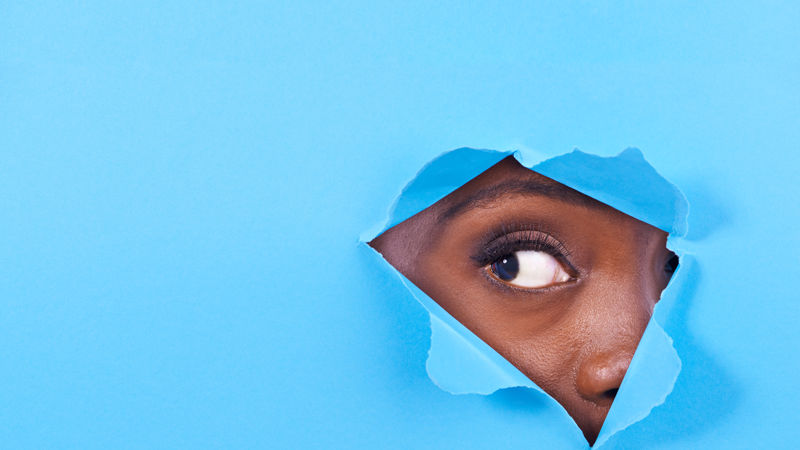The ever-changing world of fashion
From famous faces interacting with CGI models, the argument over whether influencers are helping or harming fashion's creative output, and the increasingly surprising use of celebrities, Noel Bussey examines the this season's thoughts on fashion advertising.
How has fashion advertising changed? Earlier on this year an ad broke for Calvin Klein in which real model Bella Hadid and a CGI model called Lil’Miquela made global news by kissing.
In the old days of advertising, a non-human model was called a mannequin. A small one might have been called a lil’mannequin. In the brave new world of fashion, though, new opportunities abound – even for models who don’t technically exist.
Above: Bella Hadid's kiss with Lil’Miquela, a CGI character.
There is a temptation to assume fashion advertising is all glossy photoshoots in Vogue or highly stylised, wistful films starring, as one person said (firmly tongue in cheek, by the way) “vacuous models starring into space”. But this is an outdated view of an industry remade through massive change – mainly driven by either societal issues, technological advancements or consumer attitude shifts.
In terms of body positivity, gender fluidity, age and race, fashion is doing a fantastic job in paving the way where other sections of advertising are still only following.
And nothing creates more pride in fashion's leading protagonists of change than the strides made by the industry in positively remodelling casting diversity.
Credits
powered by
- Agency Grey/London
- Production Company Park Pictures/London
- Director Georgia Hudson
-
-
Unlock full credits and more with a Source + shots membership.
Credits
powered by
- Agency Grey/London
- Production Company Park Pictures/London
- Director Georgia Hudson
- Chief Creative Officer Vicki Maguire
- Art Director Oksana Valentelis
- Creative Sam Daly
- Creative Rob Greaves
- Talent Adwoa Aboah
- Talent Alice Hurel
- Talent Felicity Hayward
- Talent Rain Dove Dubilewski
- Talent Leroy Mokgatle

Credits
powered by
- Agency Grey/London
- Production Company Park Pictures/London
- Director Georgia Hudson
- Chief Creative Officer Vicki Maguire
- Art Director Oksana Valentelis
- Creative Sam Daly
- Creative Rob Greaves
- Talent Adwoa Aboah
- Talent Alice Hurel
- Talent Felicity Hayward
- Talent Rain Dove Dubilewski
- Talent Leroy Mokgatle
Above: Zalanado's most recent commercial.
Body positive
Gijs Determeijer, a Partner and Producer at film and photography agency HALAL, says: “In terms of body positivity, gender fluidity, age and race, fashion is doing a fantastic job in paving the way where other sections of advertising are still only following. It's allowing filmmakers the ability to surprise the viewer by being original and fresh with their cast. It makes the content stand out, makes it more memorable and, at times, empowering.”
It’s no longer enough to do a couple of standout films featuring a big name and a photography campaign.
“Which, in turn, means you can speak to a wider audience,” adds Melissa Weston, UK and Ireland Marketing Lead at online fashion chain Zalando, "showing that CSR and profit don’t need to be mutually exclusive." She also points out that “an increase of more bite-size pieces of brand messaging, often through social media and an increase of video content” has had a significant impact on the direction of the industry.
It’s no longer enough to do a couple of standout films featuring a big name and a photography campaign to go with it. Campaigns now need a host of add-ons from social, vertical and out-of-home to more adventurous projects such as behind-the-scenes films or documentaries.
This rapacious content monster has seen an influx of creatives and directors enter the space from non-traditional backgrounds, weaving in their new ways of thinking.
And this rapacious content monster, and the desire to give the creative output its own make-over, has seen an influx of creatives and directors enter the space from non-traditional backgrounds, weaving in their new ways of thinking. Aaron Duffy, Co-founder of art and communication company, SpecialGuest, says; “I was pretty clear when I started working with Marcus [Wainwright, the company's founder] and his team that I know absolutely nothing about fashion. They said, "that's exactly what we're looking for". Something tells me that's a part of the evolution, and it’s a good evolution.”
Credits
powered by
- Creative Director Aaron Duffy
Above: Aaron Duffy's film for rag & bone.
Should we like influencer marketing?
Caroline Koning, a director, also at HALAL, says: “There are less narrative rules to follow and more room to build a visual atmosphere, similar to a music video. And to have people watching an abstract video that's longer than 30 seconds is an accomplishment these days.”
Influencer marketing. The ruin or saviour of fashion, depending on how you look at it.
And much of that accomplishment comes from finding, embracing and deploying new technologies, whether in the production of the campaign itself, or the clothes featuring in it. “Textiles”, Duffy says, “probably sounds like the oldest industry you can think of, but when Nike invents something like Flyknit, it becomes a big story. We're using AI technology, sensors and robotics to talk about rag & bone in their latest collections. So, I imagine that technology stories like this won't just be for tech brands. Fashion and tech play nicely together.”
Which brings us neatly to one of fashion’s biggest developments, and most vehemently argued debates; influencer marketing. The ruin or saviour of fashion, depending on how you look at it. In the blue corner, Caroline Koning. “Honestly? It has changed it for the worse because the content becomes so tailored, it loses its spark. We're starting to cut everything so specifically to everyone's needs, there are no surprises anymore. I guess that's why once in a while something super-random goes viral. Because that stuff is not planned.”
We're starting to cut everything so specifically to everyone's needs, there are no surprises anymore.
However, in the red corner is Permele Doyle, President of influencer marketing agency Billion Dollar Boy. “Influencer marketing adds personality and authenticity to fashion. Fashion brands are no longer relying on traditional photographers to showcase their collections - they are turning to digital content creators who create social-first engaging content. Consumers are savvy, and bored with endorsements and flat product mentions.”
Regardless of which side of the argument you’re on, influencer marketing has arrived and, inarguably, it is driving profit or creating new avenues of purchase. Instagram is certainly more accessible than high-fashion print media with the shoppable/checkout features making it a global shop window, accessible 24 hours a day and driving people from ad to check out in a couple of clicks.
Now there are also opportunities to create smaller and more local campaigns with local influencers who can represent the brand in a more tailored way.
“In that respect, Instagram and influencers have enhanced fashion and creativity in the medium by giving it new avenues for provocation and display," says Doyle. “Fashion on Instagram relies just as much on aspiration and fantasy as traditional high-fashion media, whilst being arguably more egalitarian in terms of access.”
Weston, agrees: “The creative process has changed. It now needs to be more personalised. There are still traditional creative processes with global teams creating global campaigns which are adapted per market, however, now there are also opportunities to create smaller and more local campaigns with local influencers who can represent the brand in a more tailored way.”

Credits
powered by
Above: The Kendall Jenner-starring Pepsi spot that showed having a famous face wasn't always a sure fire route to success.
The use of famous faces
Another area where influencers have changed the landscape is in the use of celebrity. The growth of macro, micro, nano and niche influencers and the new types of content they are creating themselves, means the line between them and classic celebrities has blurred, with Kendall Jenner’s Pepsi debacle of 2017 showing it’s not enough to just feature a big star to get views, people want to see something new.
Celebrities have a certain draw, for sure, but I think it’s more about a surprising collaboration or showing an unexpected side of either the celeb or the brand.
“Lately, I think brands have realised the risk of not being conscious about these things," says Determeijer. "Celebrities have a certain draw, for sure, but I think it’s more about a surprising collaboration or showing an unexpected side of either the celeb or the brand. Like Cardi B in Reebok’s latest ad. It captures your attention, stands out in its originality and surprises you. #Metoo also ‘forced’ brands to re-think how far they’ll rely on one celeb or one big name for their marketing. There now has to be a purpose, a creative mutual support or shared values at the heart of the campaign.”
Credits
powered by
- Agency Venables Bell & Partners/San Francisco
- Production Company Biscuit Filmworks/USA
- Director Andreas Nilsson
-
-
Unlock full credits and more with a Source + shots membership.
Credits
powered by
- Agency Venables Bell & Partners/San Francisco
- Production Company Biscuit Filmworks/USA
- Director Andreas Nilsson
- Art Director Victor Roa
- Copywriter Sam Bauer
- Creative Director Byron Del Rosario
- Executive Creative Director Will McGinness
- HP Integrated Hilary Coate
- Sound Company Barking Owl
- Managing Director Shawn Lacy
- Executive Producer Holly Vega
- Head of Production Mercedes Allen-Sarria
- Head of Production Rachel Glaub
- Editing Company Cut+Run/California
- Executive Producer Deanne Mehling
- Creative Director Phil Crowe
- Creative Director John Leonti
- Executive Producer Anastasia von Rahl
- DP Alexis Zabe
- Line Producer Grace Bodie
- Production Designer Alexis Ross
- Editor Ben Campbell
- Assistant Editor Ramon DeSouza
- Sound Design Nigel Manning
- Producer Melanie Fedunok
- Talent Cardi B

Credits
powered by
- Agency Venables Bell & Partners/San Francisco
- Production Company Biscuit Filmworks/USA
- Director Andreas Nilsson
- Art Director Victor Roa
- Copywriter Sam Bauer
- Creative Director Byron Del Rosario
- Executive Creative Director Will McGinness
- HP Integrated Hilary Coate
- Sound Company Barking Owl
- Managing Director Shawn Lacy
- Executive Producer Holly Vega
- Head of Production Mercedes Allen-Sarria
- Head of Production Rachel Glaub
- Editing Company Cut+Run/California
- Executive Producer Deanne Mehling
- Creative Director Phil Crowe
- Creative Director John Leonti
- Executive Producer Anastasia von Rahl
- DP Alexis Zabe
- Line Producer Grace Bodie
- Production Designer Alexis Ross
- Editor Ben Campbell
- Assistant Editor Ramon DeSouza
- Sound Design Nigel Manning
- Producer Melanie Fedunok
- Talent Cardi B
Above: Cardi B in Reebok's recent commercial.
However, one area where influencers, celebs, brands and fashion houses have been moving forward together is in cultivating creative collaborations. This means, as above, moving beyond a simple IG post or film to releasing exclusive capsule collections and product lines, designed by/with the influencer or celebrity themselves, such as H&M and Lydia Millen or Primark and Alice Liveing. “This allows the fashion houses and brands to leverage the person’s style, creativity and engaged community to drive awareness and sales while giving the influencer/celeb more control of their product and their own brands,” says Doyle.
Fashion is no longer “vacuous models staring into the distance”, if it ever was.
And some of the bigger influencers, such as Chiara Farragni or Leandra Medine, have already started moving this trend forward by launching their own lines and brands independent of the fashion houses, giving them total control of their own names, brands and products.
This openness to new technologies, new platforms and new models is creating a fascinating melting pot of content.
Fashion is no longer “vacuous models staring into the distance”, if it ever was. But the developments in content, context, cultural relevance, collaboration and creativity are much more far-reaching than most outside of the industry would realise. And this openness to new technologies, new ways of working with brands and their ambassadors, new platforms and new models is creating a fascinating melting pot of content.

)

















